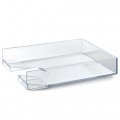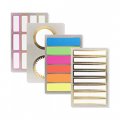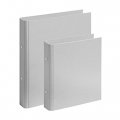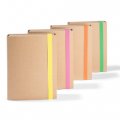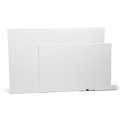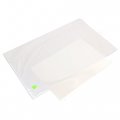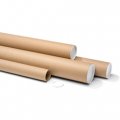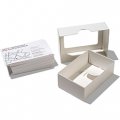+49 (0)30 690 360CO₂-neutral standard shipping free of charge from ab 89 € (DE)Free 30-day return via standard shipping (DE)
Whiteboards & Chalkboards
Information about whiteboards & magnetic boards
Whiteboards are usually white, very smooth writing surfaces that can be written on with special felt pens (whiteboard markers) and cleaned dry. The advantages are obvious: Due to the higher contrast of writing and background, the readability is better than with the classic blackboard. In addition, it can be rewritten more quickly after dry cleaning and individual words or passages can be corrected more quickly. This is one of the reasons why the classic green chalkboards have been replaced by whiteboards in many places.
Standard whiteboards with aluminium or plastic frames always look a little profane. The magnetic wall boards from the Spanish company Rocada represent a chic, simple alternative that can be regarded as an element for wall design in offices, study rooms, kitchens or children's rooms beyond its function. They have no aluminium or plastic frame, but are double-bent on all four sides. The absence of a frame is not only more beautiful and puristic, but also has the advantage that several boards can be linked directly and seamlessly with each other or combined at the corner of the wall, creating large work and presentation areas. The whiteboards can also be used as a makeshift projection surface.
Standard whiteboards with aluminium or plastic frames always look a little profane. The magnetic wall boards from the Spanish company Rocada represent a chic, simple alternative that can be regarded as an element for wall design in offices, study rooms, kitchens or children's rooms beyond its function. They have no aluminium or plastic frame, but are double-bent on all four sides. The absence of a frame is not only more beautiful and puristic, but also has the advantage that several boards can be linked directly and seamlessly with each other or combined at the corner of the wall, creating large work and presentation areas. The whiteboards can also be used as a makeshift projection surface.
Skin wallboards are not only available as whiteboards, but also as black chalkboards. The two can of course be combined - for a contrasting wall design and to work with different techniques - they have the same thickness and side lengths. Both variants can be used with magnets, Post-It's or Stattys as pinboard or moderation wall; the whiteboard can also be written with whiteboard markers, the chalkboard with chalk. In particular our chalkboard Mini, round, leaves an optimal abrasion on the lacquered surface of the chalkboards and thus provides a rich typeface.
On a whiteboard it is easy and pleasant to write, as the pen tip glides almost completely smoothly over the surface. Surely this is not everyone's cup of tea. If you prefer to scratch the surface with a piece of chalk and more resistance while writing, we recommend board foil, board varnish, chalk and/or the classic slate board.
The most important quality feature of a whiteboard is its surface. Three qualities are common:
- Melamine resin: Here you write on a melamine resin-coated sheet or a fibreboard coated in this way. However, the resin layer is less smooth than the alternative surfaces and much more sensitive to scratches. With melamine-coated fibreboards, the alternative use of magnetic adhesion is also eliminated. We do not offer this quality because the lower price does not outweigh the disadvantages of the properties.
- Painted steel: This surface is already suitable for long-term and frequent use. Such a board can also be used as a magnetic board and already has a quite robust surface, which is suitable for the use of alcohol-based whiteboard ink. However, the varnish is more susceptible to scratches, wrong detergents or the wrong ink than an enamelled surface.
- If the writing surface is used intensively, enamelled steel is recommended. Enamel is applied to a steel plate and fired at very high temperatures. This surface is even smoother, thus even easier to clean, and above all more robust than the alternatives - the surface is acid-resistant, insensitive even to harsher cleaning agents, and the fired, quite hard enamel surface is also much less sensitive to scratches. If you accidentally use an unsuitable (permanent) marker, this ink can be removed without damage.
All sizes and types can be mounted on the wall in portrait or landscape format. To attach a whiteboard to the wall, four powerful ring magnets with screws and dowels are attached to the wall using the enclosed drilling template. The board is then docked to the magnets. Thus the board remains removable and movable. So inaccuracies during drilling can also be compensated, and when several boards are chained together, they can be pushed together easily and without offset. The support rail for chalks, markers and the like can be mounted on the underside if desired, regardless of whether the board is used in landscape or portrait format. The necessary screws are included. Behind the term "blockboard" there is a variable flipchart block, better: a flipchart block holder, which can be attached to white- and chalkboards.
Whiteboards are usually built up like a framed picture. The white surface is framed by an aluminium or plastic profile and for larger (and more stable, better) versions is kept free of distortion by a backing sheet mounted on the back of the aluminium frame. Processing, construction, stability of the core and the back pull at the back are further quality features.
All whiteboards offered here are magnetic and can therefore be used as writing and magnetic boards.
As with all whiteboards, the following applies to the whiteboard: Clean as often as possible wet in order to remove dirt effectively! Although dry wiping is typical for whiteboard cleaning and of course not forbidden here, it does not replace honest wet cleaning in the medium term either - preferably with special cleaning agents such as Durable Superclean.
One last remark: When dealing with the subject of whiteboards, one can quickly come to the conclusion that more talented designers have so far ignored this subject. A wonderful alternative to the classic whiteboard in this context is the self-made version made of whiteboard foil and (for example) Dibond (unfortunately not magnetic). A writing surface that can also be wiped off dry, but is more intended for the kitchen or hallway, can be created by writing a window marker on a (smooth, not satinised!) acrylic glass plate.
One last remark: When dealing with the subject of whiteboards, one can quickly come to the conclusion that more talented designers have so far ignored this subject. A wonderful alternative to the classic whiteboard in this context is the self-made version made of whiteboard foil and (for example) Dibond (unfortunately not magnetic). A writing surface that can also be wiped off dry, but is more intended for the kitchen or hallway, can be created by writing a window marker on a (smooth, not satinised!) acrylic glass plate.
